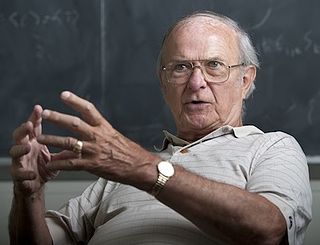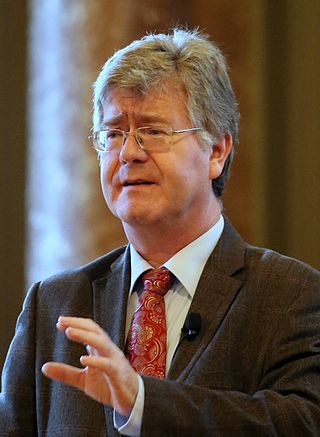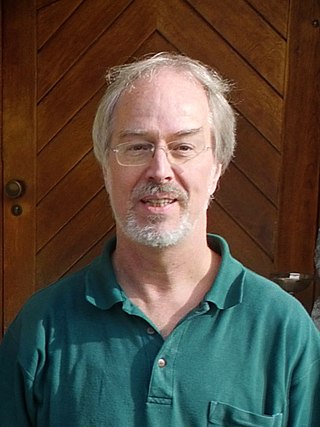Related Research Articles

Julian Seymour Schwinger was a Nobel Prize-winning American theoretical physicist. He is best known for his work on quantum electrodynamics (QED), in particular for developing a relativistically invariant perturbation theory, and for renormalizing QED to one loop order. Schwinger was a physics professor at several universities.

Willis Eugene Lamb Jr. was an American physicist who won the Nobel Prize in Physics in 1955 "for his discoveries concerning the fine structure of the hydrogen spectrum." The Nobel Committee that year awarded half the prize to Lamb and the other half to Polykarp Kusch, who won "for his precision determination of the magnetic moment of the electron." Lamb was able to precisely determine a surprising shift in electron energies in a hydrogen atom. Lamb was a professor at the University of Arizona College of Optical Sciences.
In physics, complementarity is a conceptual aspect of quantum mechanics that Niels Bohr regarded as an essential feature of the theory. The complementarity principle holds that certain pairs of complementary properties cannot all be observed or measured simultaneously. For example, position and momentum or wave and particle properties. In contemporary terms, complementarity encompasses both the uncertainty principle and wave-particle duality.

In particle physics, the history of quantum field theory starts with its creation by Paul Dirac, when he attempted to quantize the electromagnetic field in the late 1920s. Major advances in the theory were made in the 1940s and 1950s, leading to the introduction of renormalized quantum electrodynamics (QED). The field theory behind QED was so accurate and successful in predictions that efforts were made to apply the same basic concepts for the other forces of nature. Beginning in 1954, the parallel was found by way of gauge theory, leading by the late 1970s, to quantum field models of strong nuclear force and weak nuclear force, united in the modern Standard Model of particle physics.
In quantum mechanics, a quantum eraser experiment is an interferometer experiment that demonstrates several fundamental aspects of quantum mechanics, including quantum entanglement and complementarity. The quantum eraser experiment is a variation of Thomas Young's classic double-slit experiment. It establishes that when action is taken to determine which of 2 slits a photon has passed through, the photon cannot interfere with itself. When a stream of photons is marked in this way, then the interference fringes characteristic of the Young experiment will not be seen. The experiment also creates situations in which a photon that has been "marked" to reveal through which slit it has passed can later be "unmarked." A photon that has been "unmarked" will interfere with itself once again, restoring the fringes characteristic of Young's experiment.

The Schwinger effect is a predicted physical phenomenon whereby matter is created by a strong electric field. It is also referred to as the Sauter–Schwinger effect, Schwinger mechanism, or Schwinger pair production. It is a prediction of quantum electrodynamics (QED) in which electron–positron pairs are spontaneously created in the presence of an electric field, thereby causing the decay of the electric field. The effect was originally proposed by Fritz Sauter in 1931 and further important work was carried out by Werner Heisenberg and Hans Heinrich Euler in 1936, though it was not until 1951 that Julian Schwinger gave a complete theoretical description.
The wave–particle duality relation, also called the Englert–Greenberger–Yasin duality relation, or the Englert–Greenberger relation, relates the visibility, , of interference fringes with the definiteness, or distinguishability, , of the photons' paths in quantum optics. As an inequality:
Marlan Orvil Scully is an American physicist best known for his work in theoretical quantum optics. He is a professor at Texas A&M University and Princeton University. Additionally, in 2012 he developed a lab at the Baylor Research and Innovation Collaborative in Waco, Texas.
For classical dynamics at relativistic speeds, see relativistic mechanics.

François, Baron Englert is a Belgian theoretical physicist and 2013 Nobel Prize laureate.
Carl M. Bender is an American applied mathematician and mathematical physicist. He currently holds the Wilfred R. and Ann Lee Konneker Distinguished Professorship of Physics at Washington University in St. Louis. He also has joint positions as professor of physics at the University of Heidelberg and as visiting professor of applied mathematics and mathematical physics at Imperial College, London.

Carl Richard Hagen is a professor of particle physics at the University of Rochester. He is most noted for his contributions to the Standard Model and Symmetry breaking as well as the 1964 co-discovery of the Higgs mechanism and Higgs boson with Gerald Guralnik and Tom Kibble (GHK). As part of Physical Review Letters 50th anniversary celebration, the journal recognized this discovery as one of the milestone papers in PRL history. While widely considered to have authored the most complete of the early papers on the Higgs theory, GHK were controversially not included in the 2013 Nobel Prize in Physics.
Eugen Merzbacher was an American physicist.

Jonathan P. Dowling was an Irish-American researcher and professor in theoretical physics, known for his work on quantum technology, particularly for exploiting quantum entanglement for applications to quantum metrology, quantum sensing, and quantum imaging.
Herbert Walther was a leader in the fields of quantum optics and laser physics. He was a founding director of the Max Planck Institute of Quantum Optics (MPQ) in Garching, Germany. He also was Chair of Physics at Ludwig Maximilian University of Munich. He is primarily known for his experimental work on cavity quantum electrodynamics as well his groundbreaking work on the ion trap.
Cavity quantum electrodynamics is the study of the interaction between light confined in a reflective cavity and atoms or other particles, under conditions where the quantum nature of photons is significant. It could in principle be used to construct a quantum computer.

Wolfgang P. Schleich is professor of theoretical physics and director of the quantum physics department at the University of Ulm.

Gerhard Rempe is a German physicist, Director at the Max Planck Institute of Quantum Optics and Honorary Professor at the Technical University of Munich. He has performed pioneering experiments in atomic and molecular physics, quantum optics and quantum information processing.

Jun Ye is a Chinese-American physicist at JILA, National Institute of Standards and Technology, and the University of Colorado Boulder, working primarily in the field of atomic, molecular, and optical physics.

Howard John Carmichael is a British-born New Zealand theoretical physicist specialising in quantum optics and the theory of open quantum systems. He is the Dan Walls Professor of Physics at the University of Auckland and a principal investigator of the Dodd-Walls Centre. Carmichael has played a role in the development of the field of quantum optics and is particularly known for his Quantum Trajectory Theory (QTT) which offers a more detailed view of quantum behaviour by making predictions of single events happening to individual quantum systems. Carmichael works with experimental groups around the world to apply QTT to experiments on single quantum systems, including those contributing to the development of quantum computers. He is a Fellow of Optical Society of America, the American Physical Society and the Royal Society of New Zealand. He was awarded the Max Born Award in 2003, the Humboldt Research Award in 1997 and the Dan Walls Medal of the New Zealand Institute of Physics in 2017. In 2015, he was recognised as an Outstanding Referee by the American Physical Society.
References
- ↑ "CQT Research Group". Archived from the original on 2011-10-01. Retrieved 2011-08-13.
- ↑ A*STAR "Winner Citation, National Science Award". 2006. Archived from the original on 2012-03-27.
- ↑ "2018 Stanley Corrsin Award Recipient".
- 1 2 "Curriculum Vitae" (PDF). 2021-01-17. Retrieved 2023-11-16.
- ↑ "Julian Schwinger Foundation".
- ↑ List of publications
- ↑ "Citation Report: Berthold-Georg Englert". webofscience.com. Retrieved 2023-11-16.
- ↑ Scully, Marlan O.; Englert, B. G.; Walther, Herbert (1991). "Quantum optical tests of complementarity". Nature. 351 (6322): 111–116. Bibcode:1991Natur.351..111S. doi:10.1038/351111a0. S2CID 4311842.
- ↑ Berthold-Georg Englert (1996). "Fringe visibility and which-way information: An inequality". Physical Review Letters. 77 (11): 2154–2157. Bibcode:1996PhRvL..77.2154E. doi:10.1103/PhysRevLett.77.2154. PMID 10061872.
- ↑ Busch, Thomas; Englert, BG; Rzażewski, Kazimierz; Wilkens, Martin (1998). "Two cold atoms in a harmonic trap". Foundations of Physics. 28 (4): 549–559. Bibcode:1998FoPh...28..549B. doi:10.1023/A:1018705520999.
- ↑ Walther, Herbert; Varcoe, Benjamin T. H.; Englert, Berthold-Georg; Becker, Thomas (2006). "Cavity quantum electrodynamics". Reports on Progress in Physics. 69 (5): 1325–1382. Bibcode:2006RPPh...69.1325W. doi:10.1088/0034-4885/69/5/R02. S2CID 122420445.
- ↑ Durt, Thomas; Englert, Berthold-Georg; Bengtsson, Ingemar; Życzkowski, Karol (2010). "On mutually unbiased bases". International Journal of Quantum Information. 8 (4): 535–640. arXiv: 1004.3348 . doi:10.1142/S0219749910006502. S2CID 118551747.
- ↑ Schwinger, Julian (2001). Quantum mechanics : symbolism of atomic measurements. Berlin New York: Springer. ISBN 3-540-41408-8. OCLC 45835557.
- ↑ Tom Kibble (21 September 2001). "Elegant spin on journey to the very heart of the matter" (PDF). The Times Higher Education Supplement.
- ↑ "APS Fellow Archive". American Physical Society. Retrieved 2024-01-20.